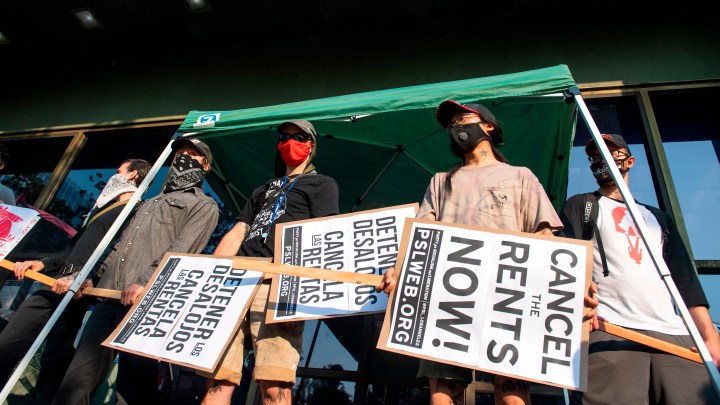
Rent-relief distribution has been slow in parts of the country. What’s going on?
Rent-relief distribution has been slow in parts of the country. What’s going on?

Millions of people in this economy still need help making their rent. And after the Supreme Court overturned President Joe Biden’s eviction ban, the distribution of around $50 billion in emergency rental assistance has been going rather slowly.
“Marketplace” host Kai Ryssdal spoke with Jessica Thomasson, executive policy director at North Dakota’s Department of Human Services, about how her office is managing the distribution of rent relief and the complications involved in the process. The following is an edited transcript of their conversation.
Kai Ryssdal: Why — and I’m gonna ask you to speak, sort of, maybe outside just North Dakota — but the larger question seems to be: Why is this so hard? And I wonder what you’re seeing.
Jessica Thomasson: Part of the challenge with delivering emergency rent assistance in this period of time is that you’re trying to connect two parties, you’re trying to connect that renter who’s experiencing housing crisis with a housing provider who is obviously experiencing disruption and need of their own, and making sure that you’re getting the right dollars to the right people in the right time — and that they meet basic eligibility criteria that have been established by the federal government. And you need to do all of that very quickly, typically, in systems that haven’t been designed to do this. So, even though conceptually it seems like something that should be kind of easy to achieve, it’s been a logistical challenge to make sure that you get all the pieces working together at the right time.
Ryssdal: How much longer do you suppose it might take before we have this running smoothly? I mean, there [is] the eviction moratorium expiring, there are benefits going away — all of those things.
Thomasson: You know, I actually think we’re seeing signs of that right now. I think these last several months, I know in our state and I know in others as well, people have been working really hard on fine-tuning what outreach looks like. It sounds counterintuitive, but a lot of times people just self-filter out. They think they don’t qualify, they think they didn’t really experience a hardship because maybe they didn’t, you know, lose their job or receive unemployment directly. But in fact, they did experience a hardship, and a lot of households are struggling even more now. And I think it’s really just helping them understand what the opportunity is for them to get back on their feet by participating in this emergency rent-assistance program. So I think we’re starting to see the benefits. I hope we all are — I wish it was faster — but I think we’re starting to see it.
Ryssdal: You used an interesting word: “outreach.” Those of us who follow news closely or who are in the news business have known about these programs. Not everybody is glued to, you know, their phones or laptops or what have you. And I imagine you have to do a certain amount of marketing to make sure people know that these programs are available.
Thomasson: More than any of us expected. I would say — and I guess I’ll speak only for myself — but we’re a state that is largely rural. It takes a real concerted effort to make sure that people understand that this is something that’s worth their time to make this application and to try to get some help.
Ryssdal: Is there opportunity here? And I’m sure you’ve explored this for community-based organizations, public-private partnerships, those kinds of things. Because what you have here is a communications problem, not a, you know, let’s-write-the-checks problem.
Thomasson: Yeah, 100%. We’re really seeing that. In North Dakota, we’re calling it an application-counseling network. So we’re working with community-based organizations across the state who are that in-community, in-person or over-the-phone or email or text, whatever-it-takes connection for somebody who might be struggling to get all the way through the process. And it’s that connecting point that we think is going to make all the difference and then allow us to make sure that we process whatever comes in the door as quickly as we can to connect that assistance to the people who need it.
Ryssdal: Take a step back and frame this in terms of the North Dakota economy, and people can make their own inferences based on the national economy. But people not getting rent assistance, aren’t able to concentrate at work, they can’t make those wages, they can’t get groceries, they can’t do all of those things that trickle down into the larger economy, right?
Thomasson: I think for all of us during the pandemic, it’s become more and more apparent that for you to be actively engaged in the workforce, you have to have some amount of stability in your everyday life, whether that’s child care, family caregiving responsibilities or stable housing. I think we are all coming to understand that this is directly connected to your ability to remain engaged in the workforce, which is, it’s what people want to do. It’s how you make your household budget work.
Ryssdal: Jessica Thomasson, she’s the executive policy director at the North Dakota Department of Human Services. Miss Thomasson, thanks for your time. I appreciate it.
Thomasson: Thanks for having me.
There’s a lot happening in the world. Through it all, Marketplace is here for you.
You rely on Marketplace to break down the world’s events and tell you how it affects you in a fact-based, approachable way. We rely on your financial support to keep making that possible.
Your donation today powers the independent journalism that you rely on. For just $5/month, you can help sustain Marketplace so we can keep reporting on the things that matter to you.












